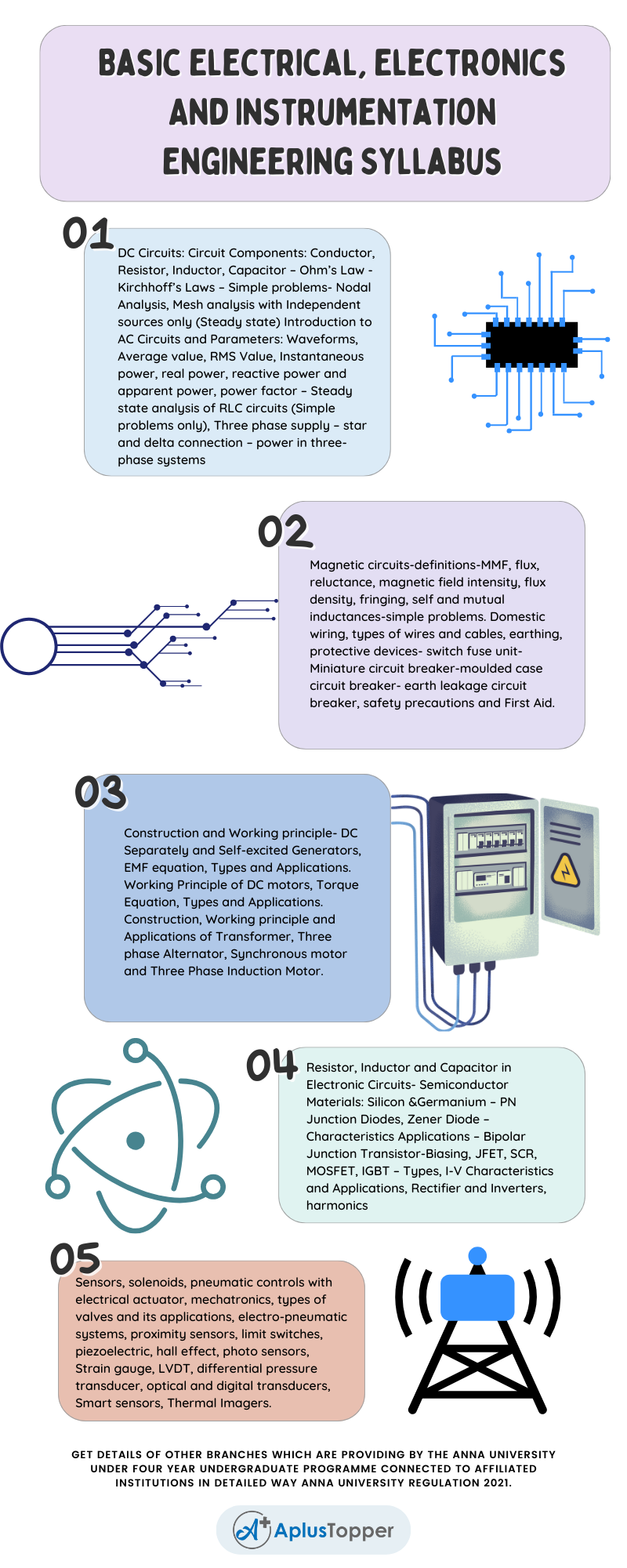Anna University, Subject code – BE3252, deals with the B.E civil Engineering Semester – II Basic Electrical, Electronics And Instrumentation Engineering syllabus regulation 2021 relating to affiliated institutions. From here, Students can get assistance in preparing notes to excel in academic performance.
We include every topic of the Basic Electrical, Electronics And Instrumentation Engineering Syllabus, to understand the subject very well. It will help you to improve your idea of syllabus of BE3252-Basic Electrical, Electronics, And Instrumentation Engineering Syllabus on your finger tips to go ahead in a clear path of preparation. In this following article Basic Electrical, Electronics, And Instrumentation Engineering Syllabus, will help you, Hope you share with your friends.
If you want to know more about the syllabus of B.E Civil Engineering connected to an affiliated institution’s under four-year undergraduate degree programme. We provide you with a detailed Year-wise, semester-wise, and Subject-wise syllabus in the following link B.E Civil Engineering Syllabus Anna University, Regulation 2021.
Aim Of Concept:
- To introduce the basics of electric circuits and analysis
- To impart knowledge in domestic wiring
- To impart knowledge in the basics of working principles and application of electrical machines
- To introduce analog devices and their characteristics
- To introduce the functional elements and working of sensors and transducers.
BE3252 -Basic Electrical, Electronics And Instrumentation Engineering Syllabus
Unit I: Electrical Circuits
DC Circuits: Circuit Components: Conductor, Resistor, Inductor, Capacitor – Ohm’s Law – Kirchhoff’s Laws – Simple problems- Nodal Analysis, Mesh analysis with Independent sources only (Steady state) Introduction to AC Circuits and Parameters: Waveforms, Average value, RMS Value, Instantaneous power, real power, reactive power and apparent power, power factor – Steady state analysis of RLC circuits (Simple problems only), Three phase supply – star and delta connection – power in three-phase systems
Unit II: Magnetic Circuits And Electrical Installations
Magnetic circuits-definitions-MMF, flux, reluctance, magnetic field intensity, flux density, fringing, self and mutual inductances-simple problems. Domestic wiring, types of wires and cables, earthing, protective devices- switch fuse unit- Miniature circuit breaker-moulded case circuit breaker- earth leakage circuit breaker, safety precautions and First Aid.
Unit III: Electrical Machines
Construction and Working principle- DC Separately and Self-excited Generators, EMF equation, Types and Applications. Working Principle of DC motors, Torque Equation, Types and Applications. Construction, Working principle and Applications of Transformer, Three phase Alternator, Synchronous motor and Three Phase Induction Motor.
Unit IV: Analog Electronics
Resistor, Inductor and Capacitor in Electronic Circuits- Semiconductor Materials: Silicon &Germanium – PN Junction Diodes, Zener Diode –Characteristics Applications – Bipolar Junction Transistor-Biasing, JFET, SCR, MOSFET, IGBT – Types, I-V Characteristics and Applications, Rectifier and Inverters, harmonics
Unit V: Sensors And Transducers
Sensors, solenoids, pneumatic controls with electrical actuator, mechatronics, types of valves and its applications, electro-pneumatic systems, proximity sensors, limit switches, piezoelectric, hall effect, photo sensors, Strain gauge, LVDT, differential pressure transducer, optical and digital transducers, Smart sensors, Thermal Imagers.

Text Books:
- D P Kothari and I.J Nagarath, “Basic Electrical and Electronics Engineering”, McGraw Hill Education (India) Private Limited, Second Edition, 2020
- A.K. Sawhney, Puneet Sawhney ‘A Course in Electrical & Electronic Measurements & Instrumentation’, Dhanpat Rai and Co, 2015.
- S.K. Bhattacharya, Basic Electrical Engineering, Pearson Education, 2019
- James A Svoboda, Richard C. Dorf, Dorf’s Introduction to Electric Circuits, Wiley,2018
References:
- John Bird, “Electrical Circuit theory and technology”, Routledge; 2017.
- Thomas L. Floyd, ‘Electronic Devices’, 10th Edition, Pearson Education, 2018.
- Albert Malvino, David Bates, ‘Electronic Principles, McGraw Hill Education; 7th edition, 2017
- Muhammad H.Rashid, “Spice for Circuits and electronics”, 4th Edition., Cengage India,2019.
- H.S. Kalsi, ‘Electronic Instrumentation’, Tata McGraw-Hill, New Delhi, 2010
Related Posts Of Semester – II:
- HS3252 – Professional English II Syllabus
- MA3251 – Statistics And Numerical Methods Syllabus
- PH3201-Physics For Civil Engineering Syllabus
